Truncated hexaoctagonal tiling
| Truncated hexaoctagonal tiling | |
|---|---|
 Poincaré disk model of the hyperbolic plane | |
| Type | Hyperbolic uniform tiling |
| Vertex configuration | 4.12.16 |
| Schläfli symbol | tr{8,6} or |
| Wythoff symbol | 2 8 6 | |
| Coxeter diagram | |
| Symmetry group | [8,6], (*862) |
| Dual | Order-6-8 kisrhombille tiling |
| Properties | Vertex-transitive |
In geometry, the truncated hexaoctagonal tiling is a semiregular tiling of the hyperbolic plane. There are one square, one dodecagon, and one hexakaidecagon on each vertex. It has Schläfli symbol of tr{8,6}.
Dual tiling
[edit]
|
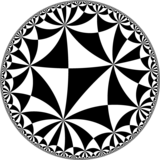
|
| The dual tiling is called an order-6-8 kisrhombille tiling, made as a complete bisection of the order-6 octagonal tiling, here with triangles are shown with alternating colors. This tiling represents the fundamental triangular domains of [8,6] (*862) symmetry. | |
Symmetry
[edit]
There are six reflective subgroup kaleidoscopic constructed from [8,6] by removing one or two of three mirrors. Mirrors can be removed if its branch orders are all even, and cuts neighboring branch orders in half. Removing two mirrors leaves a half-order gyration point where the removed mirrors met. In these images fundamental domains are alternately colored black and white, and mirrors exist on the boundaries between colors. The subgroup index-8 group, [1+,8,1+,6,1+] (4343) is the commutator subgroup of [8,6].
A radical subgroup is constructed as [8,6*], index 12, as [8,6+], (6*4) with gyration points removed, becomes (*444444), and another [8*,6], index 16 as [8+,6], (8*3) with gyration points removed as (*33333333).
| Index | 1 | 2 | 4 | |||
|---|---|---|---|---|---|---|
| Diagram | 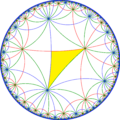
|

|
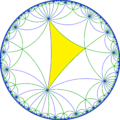
|
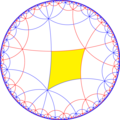
|
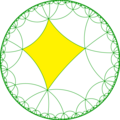
|
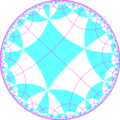
|
| Coxeter | [8,6] |
[1+,8,6] |
[8,6,1+] |
[8,1+,6] |
[1+,8,6,1+] |
[8+,6+] |
| Orbifold | *862 | *664 | *883 | *4232 | *4343 | 43× |
| Semidirect subgroups | ||||||
| Diagram | 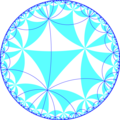
|
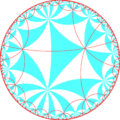
|

|
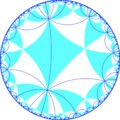
|
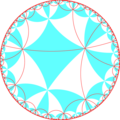
| |
| Coxeter | [8,6+] |
[8+,6] |
[(8,6,2+)] |
[8,1+,6,1+] = |
[1+,8,1+,6] = | |
| Orbifold | 6*4 | 8*3 | 2*43 | 3*44 | 4*33 | |
| Direct subgroups | ||||||
| Index | 2 | 4 | 8 | |||
| Diagram | 
|

|
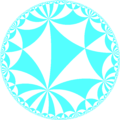
|
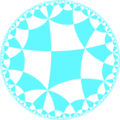
|
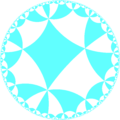
| |
| Coxeter | [8,6]+ |
[8,6+]+ |
[8+,6]+ |
[8,1+,6]+ |
[8+,6+]+ = [1+,8,1+,6,1+] | |
| Orbifold | 862 | 664 | 883 | 4232 | 4343 | |
| Radical subgroups | ||||||
| Index | 12 | 24 | 16 | 32 | ||
| Diagram | 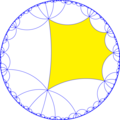
|

|

|
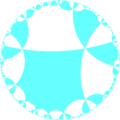
| ||
| Coxeter | [8,6*] |
[8*,6] |
[8,6*]+ |
[8*,6]+ | ||
| Orbifold | *444444 | *33333333 | 444444 | 33333333 | ||
Related polyhedra and tilings
[edit]From a Wythoff construction there are fourteen hyperbolic uniform tilings that can be based from the regular order-6 octagonal tiling.
Drawing the tiles colored as red on the original faces, yellow at the original vertices, and blue along the original edges, there are 7 forms with full [8,6] symmetry, and 7 with subsymmetry.
| Uniform octagonal/hexagonal tilings | ||||||
|---|---|---|---|---|---|---|
| Symmetry: [8,6], (*862) | ||||||

|

|

|

|

|

|

|
| {8,6} | t{8,6} |
r{8,6} | 2t{8,6}=t{6,8} | 2r{8,6}={6,8} | rr{8,6} | tr{8,6} |
| Uniform duals | ||||||

|

|

|

|

|

|

|
| V86 | V6.16.16 | V(6.8)2 | V8.12.12 | V68 | V4.6.4.8 | V4.12.16 |
| Alternations | ||||||
| [1+,8,6] (*466) |
[8+,6] (8*3) |
[8,1+,6] (*4232) |
[8,6+] (6*4) |
[8,6,1+] (*883) |
[(8,6,2+)] (2*43) |
[8,6]+ (862) |

|

|

| ||||
| h{8,6} | s{8,6} | hr{8,6} | s{6,8} | h{6,8} | hrr{8,6} | sr{8,6} |
| Alternation duals | ||||||

|
||||||
| V(4.6)6 | V3.3.8.3.8.3 | V(3.4.4.4)2 | V3.4.3.4.3.6 | V(3.8)8 | V3.45 | V3.3.6.3.8 |
See also
[edit]References
[edit]- John H. Conway, Heidi Burgiel, Chaim Goodman-Strauss, The Symmetries of Things 2008, ISBN 978-1-56881-220-5 (Chapter 19, The Hyperbolic Archimedean Tessellations)
- "Chapter 10: Regular honeycombs in hyperbolic space". The Beauty of Geometry: Twelve Essays. Dover Publications. 1999. ISBN 0-486-40919-8. LCCN 99035678.



